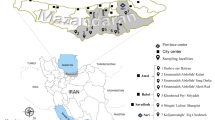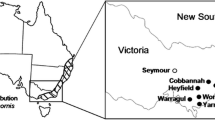Abstract
Theileria lestoquardi and T. annulata can occur in similar vectors, and current available probes based on the 18S rRNA gene showed cross-reaction between the two species. However, we developed a species-specific RFLP test based on the MspI restriction enzyme, able to cut amplified products from T. lestoquardi only and to discriminate the two species in both tick and blood samples.
Similar content being viewed by others
Avoid common mistakes on your manuscript.
Introduction
Theileria lestoquardi and T. annulata are haemoprotozoan parasites, morphologically and biologically similar, transmitted by ixodid ticks of the genus Hyalomma. Both are the causative agents of serious disease—theileriosis of small and large ruminants in tropical and subtropical countries—but they are different in the capacity to infect their hosts. T. lestoquardi readily infects sheep but is unable to infect cattle. On the other hand, T. annulata infects both cattle and sheep (Brown et al. 1998; Leemans et al. 1999a, 1999b).
The aim of the study was the differentiation of T. lestoquardi and T. annulata, using the 18S rRNA gene, as they could be present in the same tick or the same host, and previous discriminating molecular probes have failed.
Materials and methods
Isolates of T. lestoquardi (from Iran) and T. annulata (from Italy) were used in this study.
Primers R2 (5′-CTA AGA ATT TCA CCT CTG ACA GT-3′) and F2 (5′-GAC ACA GGG AGG TAG TGA CAA G-3′), covering the hypervariable region V4 adopted from Gubbels et al. (1999), were used for PCR amplification of the 18S rRNA gene. PCR products were hybridized to a reverse line blot (RLB) membrane with the specific oligonucleotide probes shown in Fig. 1, and containing an N-terminal (TFA)–C6 amino linker (Isogen). The preparation and hybridization of the RLB membrane was done as described by Gubbels et al. (1999) and Bekker et al. (2002).
The amplified products were digested with MspI restriction enzyme (Sigma) as described by the supplier, and analyzed by agarose gel electrophoresis on a 1.2% gel.
Results and discussion
Alignments of sequences of T. lestoquardi and T. annulata are different only in a few sites; one of them is at the oligonucleotide probe location for T. lestoquardi (Schnittger et al. 2004) and T. annulata (Gubbels et al. 1999) on the 18S rRNA (Fig. 1). By RLB hybridization, these two pathogens can not be distinguished (Fig. 2). The probe for T. annulata (Gubbels et al. 1999) is cross-reacting with T. lestoquardi DNA, and the T. lestoquardi probe (Schnittger et al. 2004) cross-reacts with T. annulata DNA. The necessity to differentiate between T. lestoquardi and T. annulata is implicit mainly from their occurrence in tick vectors, because the vectors could be the same for both pathogens, and T. lestoquardi and T. annulata can both be found in small ruminants. Therefore, to distinguish them, we developed a restriction fragment length polymorphism (RFLP) method by the restriction endonuclease enzyme MspI, which recognizes the following sequence: CCGG. The MspI enzyme could digest PCR products of the 18S rRNA gene of T. lestoquardi but not T. annulata (Fig. 3).
Reverse line blot (RLB) hybridization of PCR products of Theileria species. ThBa Oligonucleotide probe catches all Theileria and Babesia species; Th oligonucleotide probe catches all Theileria species; TL oligonucleotide probe, Theileria lestoquardi (Tl; Schnittger et al. 2004); TA oligonucleotide probe, T. annulata (Ta; Gubbels et al. 1999)
Restriction fragment length polymorphism (RFLP) of PCR products of the 18S rRNA gene of Theileria lestoquardi and T. annulata. Lane 1 100 bp molecular marker, lane 2 T. lestoquardi, lane 3 T. annulata, lane 4 T. lestoquardi/T. annulata ratio 1:1, lane 5 T. lestoquardi/T. annulata ratio 10:1, lane 6 T. lestoquardi/T. annulata ratio 100:1
Furthermore, we checked whether mixed infections could interfere with this test. We amplified different DNA ratios of T. lestoquardi/T. annulata (R=1, 10, 100), and results showed (Fig. 3) that unless the DNA ratio is about 100 and above, we can not see anymore the mixed infection. However, in this case we could consider that T. lestoquardi is the predominant pathogen when the DNA ratio is above 100.
Pathogens can not be distinguished in the salivary glands of infected ticks by traditional staining methods such as Feulgen or methyl green-pyronin because of their morphological similarity. Serological methods are not very effective either, as antibodies are cross-reacting. Kirvar et al. (1998, 2000) developed a PCR using specific primers to amplify only T. lestoquardi or T. annulata fragments of the gene coding a 30-kDa merozoite surface protein. The 18S rRNA gene is commonly used, compared to the gene coding the 30-kDa merozoite surface protein. This paper shows for the first time a test able to differentiate between T. lestoquardi and T. annulata occurring in identical vectors and hosts. Seeing that RLB is able to discriminate Theileria species from Babesia species, mixed infections other than T. lestoquardi/T. annulata should not be a problem.
In Mediterranean countries, for instance, where these species are often endemic, it will be of great importance to use such a method to identify the prevalence of each pathogen in tick populations, to check if small ruminants or cattle are more at risk.
We presented here a single PCR method based on the 18S ribosomal RNA gene, followed by RFLP able to give a rapid discrimination between T. lestoquardi and T. annulata. Knowing if ticks or livestock are carrying one or the other would give valuable epidemiological data, allowing to understand the prevalence and the distribution for each pathogen and the appropriate treatment method.
References
Bekker CPJ, de Vos S, Taoufik A, Sparagano OAE, Jongejan F (2002) Simultaneous detection of Anaplasma and Ehrlichia species in ruminants and detection of Ehrlichia ruminantium in Amblyomma variegatum ticks by reverse line blot hybridization. Vet Microbiol 89:223–238
Brown CGD, Ilhan T, Kirvar E, Thomas M, Wilkie G, Leemans I, Hooshmand-Rad P (1998) Theileria lestoquardi and T. annulata in cattle, sheep, and goats—in vitro and in vivo studies. Ann N Y Acad Sci 849:44–51
Gubbels MJ, de Vos AP, van der Weide M, Viseras J, Schouls LM, de Vries E, Jongejan F (1999) Simultaneous detection of bovine Theileria and Babesia species by reverse line blot hybridization. J Clin Microbiol 37:1782–1789
Kirvar E, Ilhan T, Katzer F, Wilkie G, Hooshmand-Rad P, Brown D (1998) Detection of Theileria lestoquardi (hirci) in ticks, sheep, and goats using the polymerase chain reaction. Ann N Y Acad Sci 849:52–62
Kirvar E, Ilhan T, Katzer F, Hooshmand-Rad P, Zweygarth E, Gestenberg C, Phipps P, Brown D (2000) Detection of Theileria annulata in cattle and vector ticks by PCR using the Tams1 gene sequences. Parasitology 120:245–254
Leemans I, Brown D, Hooshmand-Rad P, Kirvar E, Uggla A (1999a) Infectivity and cross-immunity studies of Theileria lestoquardi and Theileria annulata in sheep and cattle. I. In vivo responses. Vet Parasitol 82:179–192
Leemans I, Brown D, Fossum C, Hooshmand-Rad P, Kirvar E, Wilkie G, Uggla A (1999b) Infectivity and cross-immunity studies of Theileria lestoquardi and Theileria annulata in sheep and cattle. II. In vitro studies. Vet Parasitol 82:193–204
Schnittger L, Yin H, Qi B, Gubbels MJ, Beyer D, Niemann S, Jongejan F, Ahmed JS (2004) Simultaneous detection and differentiation of Theileria and Babesia parasites infecting small ruminants by reverse line blotting. Parasitol Res 92:189–196
Acknowledgements
This study was partially supported by a NATO/Royal Society Postdoctoral Fellowship awarded to Dr. E. Spitalska. The experiments presented in this paper comply with the current UK laws.
Author information
Authors and Affiliations
Corresponding author
Rights and permissions
About this article
Cite this article
Spitalska, E., Torina, A., Cannella, V. et al. Discrimination between Theileria lestoquardi and Theileria annulata in their vectors and hosts by RFLP based on the 18S rRNA gene. Parasitol Res 94, 318–320 (2004). https://doi.org/10.1007/s00436-004-1217-2
Received:
Accepted:
Published:
Issue Date:
DOI: https://doi.org/10.1007/s00436-004-1217-2







